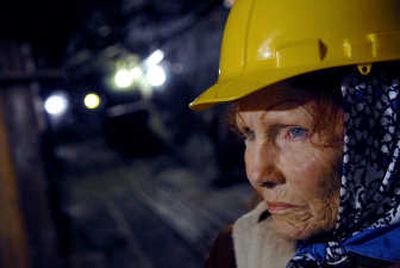Colorful history surrounds Silver Valley

Hercules. Galena. Lucky Friday. Star. Sierra. They sound like the names of racehorses, but in North Idaho’s Silver Valley everyone knows these are the mines that have shaped the area’s boom and bust cycle since the 1800s.
At the center of the Silver Valley – or as locals like to say, “at the center of the universe” – sits Wallace.
The entire town is listed on the National Register of Historic Places, and it features street after street of buildings that look the same as when they were built 100 years ago.
Funky antique shops like the North Idaho Trading Co. and Silver Capital Arts, both on Bank Street, feature everything from mineral samples to handmade candles to silver jewelry and at least one stuffed elk. There’s shopping here for every taste and checkbook.
But it’s the history of Wallace that really rocks.
Take a stroll through town and the feeling is that of being in a time capsule.
Wallace survived two huge fires; the first, in 1890, leveled the town. That was in mining’s heyday, so rebuilding began immediately. And people had gotten smart. They rebuilt in brick, so when the second fire hit in 1910, only part of the town was lost.
No matter how long visitors plan to stay, the best place to start is the Wallace District Mining Museum, at Fifth and Bank Streets. This is also the visitor’s center.
“We get people from all over the country here,” said Jim McReynolds, the executive director. Some have family roots here; some come to take advantage of the easy access to skiing in winter or summer trails like the Route of the Hiawatha and the Trail of the Coeur d’Alenes.
“I like to say that you can’t leave without doing the mining tour,” said McReynolds. “Or without trying huckleberry ice cream. You must do that.”
The Sierra Silver Mine Tour leaves by trolley from downtown, heading up Nine Mile Canyon, past the old cemetery, to the Sierra Mine, which was last active in 1985.
“They never took any ore out of here, even though they tried many times,” said Butch Jacobson, a retired miner who gave the tour. The tour is best taken in comfortable shoes – hardhats are provided – and be ready for water dripping from the low ceiling. Three exhibits show still-working, very loud mining machinery, and questions are welcome.
About being a miner in Wallace, Jacobson said: “Miners are hard-living people. They make their money, and they spend their money. Back in the day this was a very lively place.”
In the early days, Wallace was famous for its saloons and brothels.
The Oasis Bordello sits on Cedar Street, right where it opened in 1895. Today, it’s a museum where everything is left exactly as it was on the day in 1988 when the madam and the five working girls left town. Perfume sits on dressing tables and egg-timers in the kitchen are ready to be set for clients according to the posted pricelist.
Just around back sits the Northern Pacific Railroad Depot Museum, housed in the old railroad building. The building was an extravagant piece of chateau-style architecture when it was built in 1901. When I-90 came through Wallace, the depot was moved out of the way and preserved.
Today, it houses a miniature train set and a gift shop, the original waiting rooms and ticket booths, as well as a collection of train memorabilia on the second floor.
From Wallace it’s easy to take road trips to nearby Kellogg – another mining town with historic buildings and the home of Silver Mountain Ski Resort – or St. Maries at the south end of Lake Coeur d’Alene.
One lesser-known trip takes you north of Wallace over Dobson Pass (when the road is open) and down into the tiny town of Murray. Here, you’ll find the Sprag Pole Inn and Museum. Look for two towering totem poles and you’ve found it.
Imagine someone’s bar collection run amok, filling shelf after shelf with collectible whiskey jugs, glasses, plates, porcelain and hundreds of mineral samples, and it’ll give you a pretty good idea about the Sprag Pole.
It’s been in the Almquist family since 1933, and today it’s a registered nonprofit organization.
There’s a small mining exhibit, firefighting tools and horse-drawn rigs, as well as a model of a physician’s office from 100 years ago.
Not exactly what you’d expect to come across in the back of a bar, but that’s what makes the Silver Valley such a memorable destination: You never know exactly what you’re going to find around the next bend in the road.